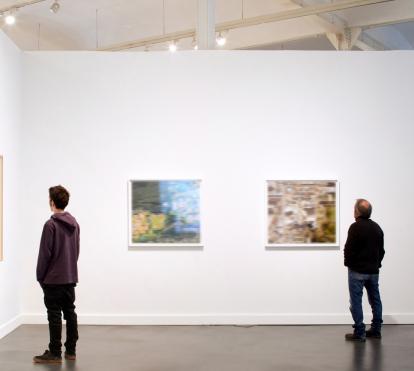
As of 1915, Kazimir Malevich's abstract geometric works, like his trademark Black Square and White on White paintings, began to revolutionise the way in which art was perceived. The spirit of innovation that distinguished this Russian artist helped him open new paths of expression, which became the key references to comprehend 20th century art. The exhibition Malevich and Film, organised by ”la Caixa” Foundation and Lisbon's Centro Cultural de Belém, reflects the historic course of the Suprematist movement, which fed an in-depth process of reflection on artistic creation, especially in terms of spatial experience, photography and cinema. The exhibition brings together 125 works by thirty artists from Russia and other countries, from Malevich's times and afterward, who have in common a desire to break out of the "prison" of modern canons and blaze new trails: Malevich, El Lissitzky, Hans Richter, Aleksandr Rodchenko, Robert Rauschenberg, Sol LeWitt, Piero Manzoni, Allan McCollum, Yves Klein and Richard Serra, among others. Likewise, anonymous graphic material is displayed: posters, photo books, magazine covers and film scenes shot in black and white by Sergei Eisenstein and Dziga Vertov. The works have been taken from different institutions, such as the Russian National Archive of Literature and Art, the Tretiakov State Gallery, the Getty Research Institute, etc. The exhibition Malevich and Film, with Margarita Tupitsyn as organiser, can be visited at the Sala de Exposiciones of Madrid's ”la Caixa” Foundation (Serrano, 60), from 13 November, 2002 to 12 January, 2003.The influence of Kazimir Malevich (Kiev, 1878 - Leningrad, 1935) on modern art is universally acknowledged, though little echoed in exhibitions. The Russian painter and designer is given credit for being the founder of Suprematism (1915), an abstract geometric style that was continued and developed by several artists. His post-Suprematist figurative work created at the end of the 1920's is still generating controversy, since for an extended period of time it has been interpreted as a change of direction in his career caused by the increasingly fervent criticism of abstract art on the part of Soviet state officials.Malevich and Film shows how the artist's departure from abstraction toward 1928 and the consequent creation of figurative works are related with his writings on contemporary Soviet cinema, in general terms, and with cinema directors Dziga Vertov and Sergei Eisenstein, among others. "It is necessary to study the forms of pictorial representation because, in any event, the influence of painting on the composition of the cinematographic stills, and the presentation of films' themes continues to have an "easel" effect," wrote Malevich in an article published in 1929 in the magazine Cinema and Culture with the title, "Pictorial Laws in Cinematographic Problems".A copy of this magazine is one of many works and objects shown at the Madrid exhibition. There are also oil paintings, drawings, lithographs, letterset prints, sculptures, designs, films, scenes from films, photo albums, letters, manuscripts and anonymous graphic material. The exhibition's discourse is articulated in three main areas: first, a number of works by Malevich and his contemporaries are displayed, next there is a collection of film posters and graphic material from the 1920's, and finally, a collection of artists' post-World War II works.The visit to the exhibition begins with a set of paintings and designs by Malevich and his Suprematist cohorts, with special emphasis given to black and white Soviet films from the 1920's. Afterwards, there is a space designed for showing Vertov and Eisenstein's films, accompanied by Malevich's articles. Next comes the figurative work of the Russian painter and designer, created at the end of the 1920's and the beginning of the 1930's. These works reveal the artist's fascination with cinema, and especially film's capacity to fuse abstraction and reality. This first ambit houses some fifty oil paintings and drawings by Malevich, in addition to several examples of his writing such as a letter to Eisenstein dated 1928 and works by contemporaries Ilya Chashnik, Aleksei Gan, Gustav Klutsis, Lev Kuleshov, Anton Lavinsky, Anna Leporskaya, El Lissitzky, Hans Richter, Aleksandr Rodchenko, Iakov Ruklevskii, Vladimir and Georgii Stenberg, Nikolai Suetin and Mikhail Veksler.Second, there is a gallery of posters advertising period films, such as The Strike (1925), Battleship Potemkin (1926) and October (1928), all by Sergei Eisenstein; The Eleventh Year (1928), by Dziga Vertov, and Children of the Storm (1926), by Fridrikh Ermler, among other films. Another part of the exhibition features a wealth of anonymous graphic material, such as movie magazine covers, scenes from film shoots and photo albums.The exhibition reaches its peak with a selection of works by artists from the second half of the 20th century who shared Malevich's desire to break free from the modernist canon through the cinematic imaginative forms. Among these artists are Josef Albers, Art & Language, Eric Bulatov, Ilya Kabakov, On Kawara, Yves Klein, Vitaly Komar and Aleksandr Melamid, Sol LeWitt, Piero Manzoni, Allan McCollum, Alex Hay, Steve Paxton and Robert Rauschenberg, Richard Serra, Leonid Sokov and Oleg Vassiliev. Malevich and FilmFrom 13 November, 2002 to 12 January, 2003Sala de Exposiciones of the ”la Caixa” FoundationCalle Serrano, 60MadridTelephone: 902 22 30 40Hours:Monday to Saturday, 11 am to 8 pmSunday and holidays, 11 am to 2:30 pmTuesdays, closedFree admissionwww.fundacio.lacaixa.es